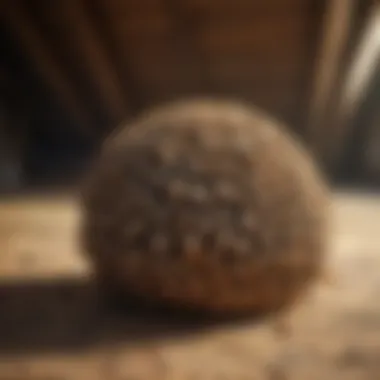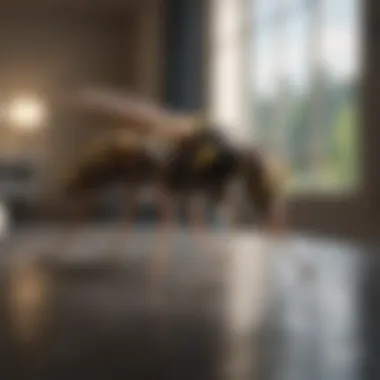Expert Guide on Managing a Wasp Inside Your Home


Preventive Pest Control Strategies
Taking proactive measures to prevent pest infestations is crucial for maintaining a pest-free home environment. Starting with safeguarding the perimeter of your house, it is recommended to seal any visible cracks along the walls and foundation. Regularly inspecting and clearing debris from your yard can eliminate potential hiding spots for pests. Furthermore, implementing barriers to prevent pests from entering, such as installing door sweeps and window screens, is essential.
When it comes to yard maintenance, adopting essential routines like mowing the lawn regularly, pruning bushes away from the house, and removing standing water can significantly reduce pest attraction. By keeping your yard well-maintained and free of clutter, you can minimize the risk of pest infestations.
Maintaining indoor cleanliness is another key aspect of preventive pest control. Utilizing expert cleaning tips and techniques, such as regularly vacuuming carpets, wiping down surfaces with disinfectant, and decluttering areas prone to pest activity, can deter insects and rodents from taking up residence in your home.
Proper garbage disposal is also instrumental in preventing pest infestations. Opt for efficient waste disposal methods, such as using sealed bins, composting organic waste properly, and promptly removing trash from your property. Ensuring that garbage cans are tightly sealed and kept away from the house can help deter pests attracted to food sources.
In addition to these measures, exploring innovative ways to safeguard your home against pests, such as using natural repellents like diatomaceous earth or installing ultrasonic pest deterrents, can offer added protection. By implementing a combination of these preventive strategies, you can create a hostile environment for pests and safeguard your home effectively.
Understanding Wasp Behavior
In the realm of pest management, understanding wasp behavior is a crucial element to effectively deal with these unwelcome guests. By comprehending the behavioral patterns and tendencies of wasps, individuals can better equip themselves to handle encounters with these insects in a safe and efficient manner. This section serves as a foundation for the subsequent steps in the guide, laying the groundwork for strategies that are rooted in knowledge and insight.
Identifying Wasp Species
When it comes to identifying wasp species, a keen eye is necessary to distinguish the various types that may be encountered indoors. Common wasp species found indoors differ in characteristics such as coloring, size, and nesting habits, all of which play a role in understanding their behavior. By recognizing these distinctions, homeowners can tailor their approach to dealing with specific species, ensuring a targeted and effective response.
Common Wasp Species Found Indoors
One prevalent indoor wasp species is the paper wasp, known for its distinctive brown coloration and unique nesting habits. These wasps are often attracted to sheltered areas within homes where they can build their characteristic paper-like nests. Understanding the behavior of paper wasps is essential as their nests can pose a threat if disturbed, making them a significant focus for homeowners facing such intrusions.
Differences Between Wasps and Bees


Differentiating between wasps and bees is another critical aspect of identifying the species present in a household. While both insects play vital roles in the ecosystem, wasps tend to exhibit more aggressive behavior compared to their pollinator counterparts. Recognizing these behavioral disparities is key in devising appropriate strategies for addressing a wasp presence in the home, taking into account the potential risks associated with their behavior.
Reasons for Wasp Intrusion
Understanding the reasons behind wasp intrusion sheds light on the motivations driving these insects into residential spaces. By delving into the factors that attract wasps, homeowners can implement preventative measures to deter future invasions, creating an inhospitable environment for these pests.
Search for Food Sources
Wling food sources. By being aware of the types of food that may attract wasps, individuals can implement proper storage practices to minimize the risk of infestation, ultimately reducing the likelihood of encountering these insects indoors.
Seeking Shelter
The quest for shelter drives many wasps to seek refuge in homes, drawn to hidden or undisturbed areas that provide protection. Understanding this behavior allows homeowners to identify vulnerable entry points and proactively secure their living spaces, preventing wasps from establishing nests within the premises. By addressing shelter-seeking tendencies, individuals can fortify their homes against potential incursions, fostering a safe and pest-free environment.
Initial Steps to Take
When dealing with a wasp in your home, the initial steps you take are crucial for ensuring a safe and successful resolution to the situation. Stay calm and composed as your first course of action. By remaining calm, you reduce the risk of provoking the wasp, which could lead to stings or a more agitated insect. Slow, deliberate movements are key during this phase to prevent startling the wasp further. Isolating the area where the wasp is spotted is also vital. This involves closing doors and windows to prevent the wasp from moving to other parts of the house. By limiting the wasp's movement, you decrease the chances of an unwanted surprise encounter. Following these steps diligently sets the foundation for a smooth resolution.
Maintain Calmness
The importance of staying composed
Remaining composed in the presence of a wasp is critical to preventing unnecessary panic or danger. When you stay calm, you emit a sense of peace that can influence the wasp's behavior. Wasps are sensitive to sudden movements and loud sounds, so by staying composed, you lower the risk of provoking them. This composed demeanor is a key element in effectively handling a wasp encounter, as it promotes a safer environment for both you and the insect. The advantage of staying composed lies in maintaining control of the situation and reducing the likelihood of a negative outcome. Although it may be challenging, the unique feature of calmness is its ability to de-escalate the tense atmosphere, creating a more harmonious resolution.
Avoid sudden movements


Avoiding sudden movements is equally important when dealing with a wasp. Rapid or erratic motions can startle the insect, triggering defensive behavior. By moving slowly and purposefully, you minimize the chances of agitating the wasp. This deliberate action is a popular choice because it reduces the risk of being stung. The key characteristic of avoiding sudden movements is the ability to navigate the situation with precision, decreasing the potential for any unwanted interactions. The advantage of this approach is evident in the controlled atmosphere it creates, leading to a more peaceful resolution. While it may require patience, the unique feature of movement restriction is its effectiveness in maintaining a non-threatening environment.
Isolation of the Area
Closing doors and windows
Closing off the area where the wasp is located is a strategic move to contain the insect and prevent it from spreading to other parts of your home. By shutting doors and windows, you establish a barrier that limits the wasp's exploration, reducing the risk of a surprise encounter in another room. This restriction plays a crucial role in managing the situation effectively. The key characteristic of closing doors and windows is its ability to create a defined boundary, helping you maintain control over the environment. This method's advantage lies in confining the issue to a specific area, simplifying the resolution process. While it may not eradicate the problem entirely, the unique feature of isolation promotes a focused approach to addressing the wasp intrusion.
Limiting the wasp's movement
Once you have closed off the area, it's essential to further limit the wasp's movement within that space. Restricting the insect's ability to fly freely lowers the chance of accidental encounters. By confining the wasp to a specific zone, you gain a sense of predictability, making it easier to address the situation. The key characteristic of limiting movement is the assurance it brings, knowing where the insect is at all times. This approach's advantage is in providing a controlled environment for handling the wasp, minimizing the scope of potential interactions. The unique feature of movement limitation is its role in instilling a sense of security, aiding in a more organized resolution.
Safe Wasp Removal Techniques
When dealing with a wasp infestation, it is crucial to focus on safe removal techniques to ensure both your safety and the effective elimination of the pests. In this article, the section on Safe Wasp Removal Techniques delves into specific elements that are essential for successfully managing a wasp presence in your home. By emphasizing the importance of adopting safe practices, readers will gain valuable insights into the benefits of prioritizing cautious removal methods and the considerations that need to be taken into account for a successful resolution.
Using Natural Deterrents
Peppermint oil
Peppermint oil serves as a natural deterrent for wasps due to its strong and distinctive scent, which repels these insects effectively. Its key characteristic lies in its ability to disrupt the delicate scent trails that wasps use to communicate with each other, making it an ideal choice for deterring them from your living spaces. The unique feature of peppermint oil is its non-toxic nature, making it safe for household use. While peppermint oil has numerous benefits for wasp control, one must also be mindful of its disadvantages, such as the need for regular reapplication to maintain its effectiveness in warding off these pests.
Citrus spray
Citrus spray acts as another effective natural deterrent against wasps, harnessing the power of citrus scents to repel these insects from your home. Its key characteristic rests in the strong yet pleasant odor that citrus carries, which wasps find displeasing and avoid. This makes citrus spray a popular choice for those looking to deter wasps without the use of harsh chemicals. The unique feature of citrus spray is its ability to provide a refreshing aroma while also serving as an efficient wasp repellent. Despite its advantages, users should be cautious of potential disadvantages such as the need for reapplication after some time to maintain its effectiveness.


Professional Pest Control Services
Contacting exterminators
Contacting professional exterminators can significantly contribute to resolving a wasp intrusion by deploying targeted and effective methods for eliminating these pests. The key characteristic of seeking professional help lies in their expertise and specialized tools that enable them to tackle wasp infestations efficiently. By choosing this option, individuals benefit from timely and thorough remedies for their pest concerns. However, it is important to note the potential disadvantages, such as associated costs and the reliance on external expertise.
Benefits of professional help
The benefits of seeking professional pest control services are vast, as they bring in-depth knowledge and experience to address complex pest issues effectively. The key characteristic of professional help is their ability to tailor treatment plans to specific infestations, ensuring a higher success rate in eradication. By enlisting professional assistance, individuals can enjoy the advantages of long-term solutions and peace of mind that the pest problem will be tackled comprehensively. While the benefits are significant, potential disadvantages may include cost considerations and the need for ongoing maintenance to prevent future infestations.
Preventive Measures
When dealing with a potential wasp issue in your house, taking preventive measures can be instrumental in avoiding future infestations. By proactively addressing entry points and maintaining cleanliness, you can significantly reduce the risk of wasps invading your living space. Preventive measures play a crucial role in this comprehensive guide as they focus on averting problems before they arise, ensuring a harmonious living environment for you and your family.
Inspecting Entry Points
Checking for openings
Checking for openings is a critical step in identifying vulnerable areas where wasps could enter your home. Whether it's gaps in windows, doors, or cracks in walls, being thorough in your inspection can help pinpoint potential entry points. This meticulous approach to checking for openings allows you to strategically seal off access routes, impeding wasps from entering and building nests indoors. The key characteristic of checking for openings lies in its preemptive nature, offering a proactive stance against unwelcome intruders. By diligently examining all possible entry points, you demonstrate a proactive mindset towards pest control in your living space.
Sealing cracks and gaps
Sealing cracks and gaps serves as a protective barrier against not only wasps but other pests as well. By addressing structural vulnerabilities in your home, such as gaps around pipes, vents, or crevices in walls, you strengthen your defense against potential intruders. The main advantage of sealing cracks and gaps is the long-term protection it provides, creating a fortified shield that deters pests from entering. This methodical approach to sealing off entry points ensures that your home remains a secure haven, free from the disruptions caused by unwanted insect guests.
Maintaining Cleanliness
Proper food storage
Proper food storage is key in minimizing attractants for pests like wasps. By storing food in airtight containers and promptly cleaning up spills or crumbs, you eliminate food sources that may entice these insects into your home. The central characteristic of proper food storage lies in its ability to starve off potential pests, reducing the likelihood of infestations. This approach is popular for its simplicity yet effectiveness in creating an inhospitable environment for unwanted visitors.
Regular cleaning routines
Establishing regular cleaning routines contributes significantly to preventing pest infestations, including those of wasps. Consistent cleaning practices, such as vacuuming regularly, wiping down surfaces, and disposing of trash promptly, help eliminate traces of food or scents that could attract pests. The key advantage of maintaining regular cleaning routines is the continual upkeep of a sanitary living space, discouraging pests from taking up residence. The commitment to regular cleaning not only enhances the aesthetic appeal of your home but also plays a crucial role in pest prevention, safeguarding your living environment for you and your family.



